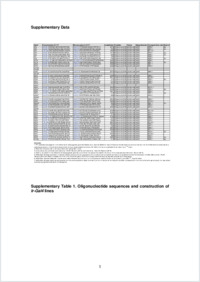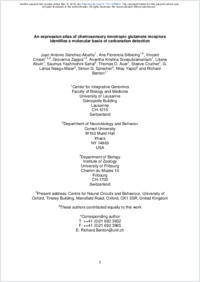An expression atlas of chemosensory ionotropic glutamate receptors identifies a molecular basis of carbonation detection
- Sánchez-Alcañiz, Juan Antonio Center for Integrative Genomics, Faculty of Biology and Medicine, University of Lausanne, Switzerland
- Silbering, Ana Florencia Center for Integrative Genomics, Faculty of Biology and Medicine, University of Lausanne, Switzerland
- Croset, Vincent Center for Integrative Genomics, Faculty of Biology and Medicine, University of Lausanne, Switzerland
- Zappia, Giovanna Center for Integrative Genomics, Faculty of Biology and Medicine, University of Lausanne, Switzerland
- Sivasubramaniam, Anantha Krishna Center for Integrative Genomics, Faculty of Biology and Medicine, University of Lausanne, Switzerland
- Abuin, Liliane Center for Integrative Genomics, Faculty of Biology and Medicine, University of Lausanne, Switzerland
- Sahai, Saumya Yashmohini Department of Neurobiology and Behavior, Cornell University, Ithaca, NY, USA
- Auer, Thomas O. Center for Integrative Genomics, Faculty of Biology and Medicine, University of Lausanne, Switzerland
- Cruchet, Steeve Center for Integrative Genomics, Faculty of Biology and Medicine, University of Lausanne, Switzerland
- Neagu-Maier, G. Larisa Department of Biology, Institute of Zoology, University of Fribourg, Switzerland
- Sprecher, Simon G. Department of Biology, Institute of Zoology, University of Fribourg, Switzerland
- Yapici, Nilay Department of Neurobiology and Behavior, Cornell University, Ithaca, NY, USA
- Benton, Richard Center for Integrative Genomics, Faculty of Biology and Medicine, University of Lausanne, Switzerland
-
08.03.2018
English
Taste perception is thought to involve the encoding of appetitive and aversive chemical cues in food through a limited number of sensory pathways. Through expression analysis of the complete repertoire of Drosophila Ionotropic Receptors (IRs), a sensory subfamily of ionotropic glutamate receptors, we reveal that the majority of IRs is expressed in diverse peripheral neuron populations across gustatory organs in both larvae and adults, implying numerous roles in taste-evoked behaviours. We characterise Ir56d, which labels two anatomically-distinct classes of neurons in the proboscis: one represents a subset of sugar- and fatty acid-sensing neurons, while the other responds to carbonated solutions and fatty acids. Mutational analysis shows that IR56d, together with the broadly-expressed co-receptors IR25a and IR76b, is essential for physiological activation by carbonation and fatty acids, but not sucrose. We further demonstrate that carbonation is behaviourally attractive to flies (in an IR56d-dependent manner), but in a distinct way to other appetitive stimuli. Our work provides a valuable toolkit for investigating the taste functions of IRs, defines a molecular basis of carbonation sensing, and illustrates how the gustatory system uses combinatorial expression of sensory receptors in distinct neuron types to coordinate behaviour.
- Faculty
- Faculté des sciences et de médecine
- Department
- Département de Biologie
- Language
-
- English
- Classification
- Biological sciences
- License
- License undefined
- Identifiers
-
- RERO DOC 308973
- DOI 10.1101/278804
- Persistent URL
- https://folia.unifr.ch/unifr/documents/306526
Other files
Statistics
Document views: 52
File downloads:
- spr_eac_sm.pdf: 149
- spr_eac.pdf: 182

